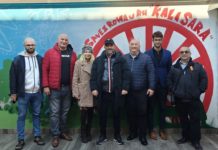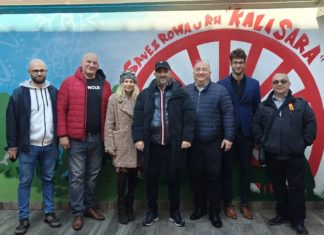I am not welcome to coexist, I am forced to segregate, and then my settlement is destroyed, I am subject to illegal evictions, my culture is appropriated for fashion novelty, my child’s schooling is restricted. Am I dangerous or is the truth uncomfortable?, Ildiko Nova asks in her work, the Roma Storyteller. With this work, Nova participated in The Dangerous Women project organized by the Institute for Advanced Studies in Humanities at the University of Edinburgh, which questioned the idea of how dangerous women are individually or collectively, and which permeates many historical periods, cultures and areas of modern life, despite and, in some cases, in response to explicitly feminist movements. The interests of this artist, a Hungarian native, and with a current address in Canada, include human rights issues for vulnerable, marginalized communities and ethnic groups, but also animal welfare and their treatment in urban conditions. Imbued with the experiences of living in the Roma community in Eastern Europe, she accepts the invitation of her Aboriginal schoolmates in Canada to learn about their culture, so that ultimately new knowledge and awareness is reflected in her art. It was precisely with this topic that we began our conversation.
I live in a Central Canadian city, with a huge urban Indigenous presence. There is a noticeable tension between the mainstream society and the Aboriginals. It is necessary to have a quick historical review of the situation to understand it. The insatiable for-profit white colonization stands in the background of the case. The first Europeans were warmly received by the natives, helping them to survive this harsh climate. Trade relations have been established. Then, with the growing number of arrivals, the rulers of the European continent (England, France) began to impose their own laws on this continent. The Christian conversion also appeared, along with the intention to abolish indigenous culture. That is why they took the children from their families and locked them in institutions. To kill the Indian in them, they said in residential schools.
As a consequence of what has been described above, trust obviously has been shaken, and it continues to this day. In 2015 The Truth and Reconciliation Commission was established to offer proper knowledge about the atrocities of the past and with the invitation the entire society to learn in order to improve nation to nation relationships. I have to see myself on this land as a guest (and a settler) and should carry myself with respect to First Nation people.
I personally feel really honored and privileged that I had a chance to learn about the Aboriginal culture through traditional ceremonies. Their teachings have seven symbolic elements and it is a guidance for all situations. These are Love, Honesty, Wisdom, Courage, Humility, Respect and Truth. I have learned a great deal of courage from strong Indigenous women. Also, ways of compassion are expressed through community and mutual support is very important. Superiority of members of society is not acceptable.
All decisions should consider the environment and its health. These teachings influenced my own work, because I want to represent Roma people in the most positive way in order to fight harmful stereotypes and racism. I want to honor girls and women who face hardship. I also reflect on my love of animals. I feel honored that I have an insight of both cultures, Romani and Indigenous.

You were born in Hungary under Soviet occupation, and as a child you were adopted by non-Roma parents. What memories do you carry from that period and when did you find out that you have Roma roots?
I felt a great deal of disillusionment from early on. All levels of communication (family, school, state) were liars and it bothered me. The country had to obey Soviet rules, and freedom of expression, especially disagreement or criticism was banned. On a personal level, my ethnicity has never been revealed or discussed. I did not even feel different until my environment told me. Teachers rewarded white kids for less results, I often was excluded without knowing the reasons. There was a strong gap between “them” and “me” and it surprised me.
You are mostly a self-taught artist, although you have attended some courses at George Brown College in Toronto. How did that self-learning go and did you face discrimination in that process?
All my studies at George Brown College, Toronto were very positive experiences. I studied in the community worker program. In those days, my Human Rights studies helped me to identify myself and it helped my personal journey since. I worked as a community worker with different groups in Toronto. I helped newcomer Hungarian Roma families with their refugee applications. Unfortunately, the Canadian emigration policies were very hostile, so most of them were refused and deported back to Hungary. This experience made me realize the privileges of being a Canadian citizen.
You even lived in Germany as a refugee for some time. It is clear that community is important to you and the feeling of local affiliation, as well. How does that reflect on your art?
I lived in Germany with my family for almost four years as refugees. We were allowed to work minimal hours. The government wanted to keep their workplaces homogenous with German workers. Communities are important to me, because that’s the source of basic belonging. Also the fabric of society is very colorful, so inclusion should be part of it. There is always more to learn from each other. The focus of my art is positive representation of the Roma people and disadvantaged minorities in order to fight negative stereotypes. There are hardworking individuals and their stories have to be heard to change the narrative.
Indeed, it is important breaking the stereotypes. What role does art play in that?
Stereotypes are distorted, simplified and ignorant statements and their circulation is in the hand of the least educated crowd. There are available academic studies on all areas but reading them requires effort and invested time. Art works as a bridge, and creates a more peaceful, interesting, instant dialog and can reach a surprisingly wide audience, even if we are not aware of it. Hopefully a cathartic experience can open up to more positive responses.
In one of your works Roma Storyteller, through the vision of a Roma woman, you ask yourself Am I dangerous or is the truth unpleasant? What does it mean to be a dangerous woman from the perspective of your work?
The Dangerous Women Project was a call for submissions on behalf of Edinburgh University a few years back. I am proud to be selected to share the Roma Storyteller. I realized that societies have groups that are vulnerable yet pushed away. Furthermore, the lack of political will to offer real, compassionate solutions, there are only “bandage” problem solving. For example homelessness, dishonored land claims, post war conditions, disability exclusion, poverty etc. Politicians scapegoat these marginalized groups and by doing so, count on their own popularity by mainstream members. I think it is important to correct these stereotypes. Also, matriarchy makes so much sense, where women as life givers have a different perspective on life, environment and social values.
Who inspired or influenced your work?
My favorite artist is Henry de Toulouse Lautrec, he shows disempowered people, especially women and creates a presence for them. I also appreciate grassroot mural makers, and some street art, where you can detect the feel of a community from close. Also, the local Indigenous art amazes me, their work is so honest and never pretentious.
What are the challenges and phenomena that you have encountered in your experience when it comes to the domain of women’s work in culture, but also in the context of the presentation of the Roma community nowadays?
It takes consistency and strength to be present as a female in art. I work as a freelance and try to submit my art online and worldwide. Often, there is no interest to hear about the Roma, but there are successes as well. I am getting to know more Roma artists and academics internationally, so far it is very positive. Minorities need to find common grounds with each other in order to be louder for human rights together.
How would you comment on the evaluation of artistic work in society, and how much do class and gender affect artistic careers?
There are different art scenes. I do not fit the local, white, mainstream. It amazes me who gets the forum and why. There are a lot of preconceptions and assumptions about artists and in people, in a general sense. Rejections based on these can be really bad for mental health. But it did not stop me, I found my ways and kept fighting for my voice.
How important is it that female artists and women in general support each other, in the wider movement and vision?
Female support system should be relationship based, and positive where storytelling is a collaborative effort, and it is important to share knowledge and experiences. There are several systemic barriers that vulnerable groups need to fight, such as lack of social services, racialized poverty and stigma, just to name a few. Participants need to see the “big picture” and to contribute ideas. Horizontal oppression can cause lack of focus and delays in progression.















